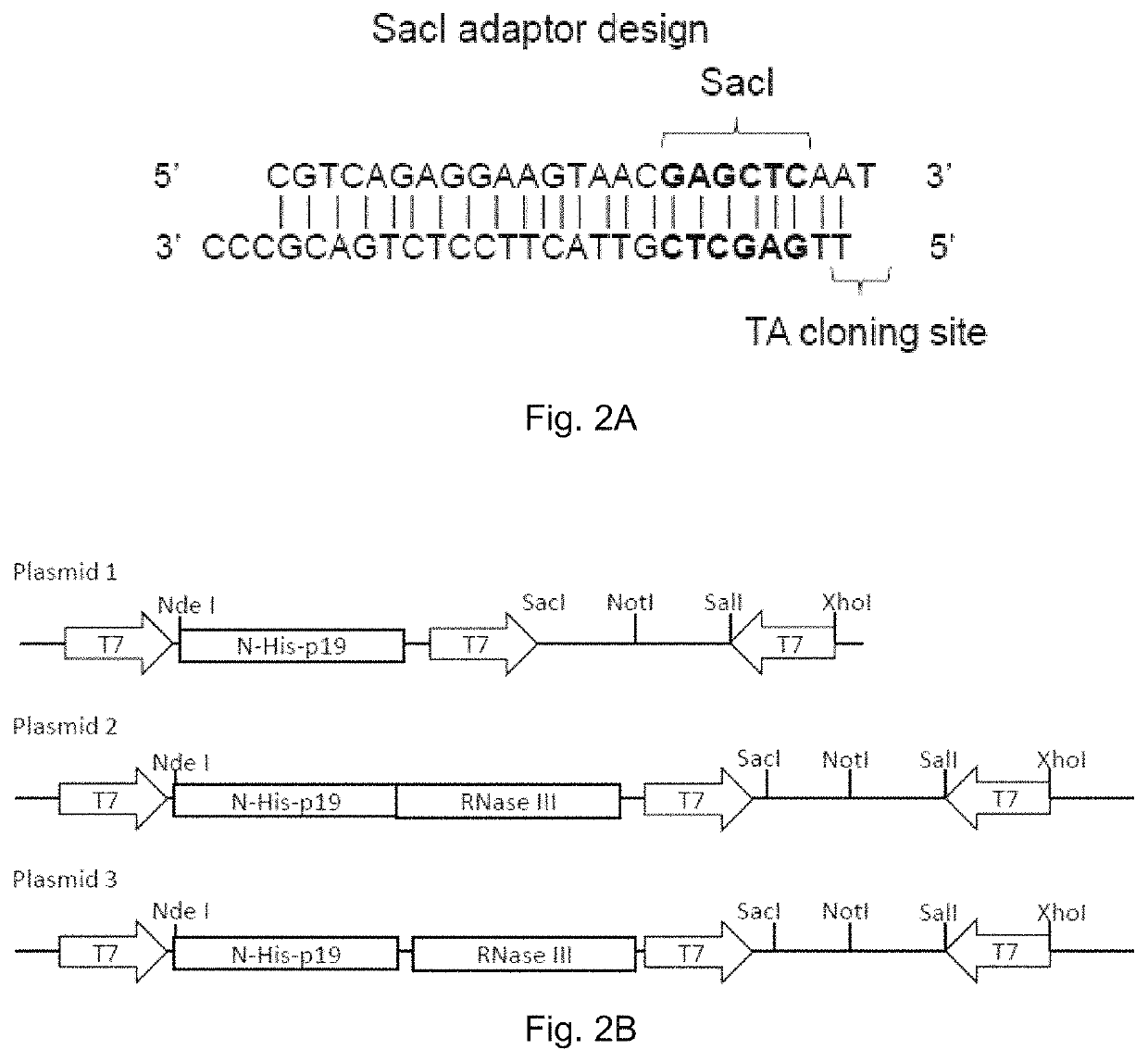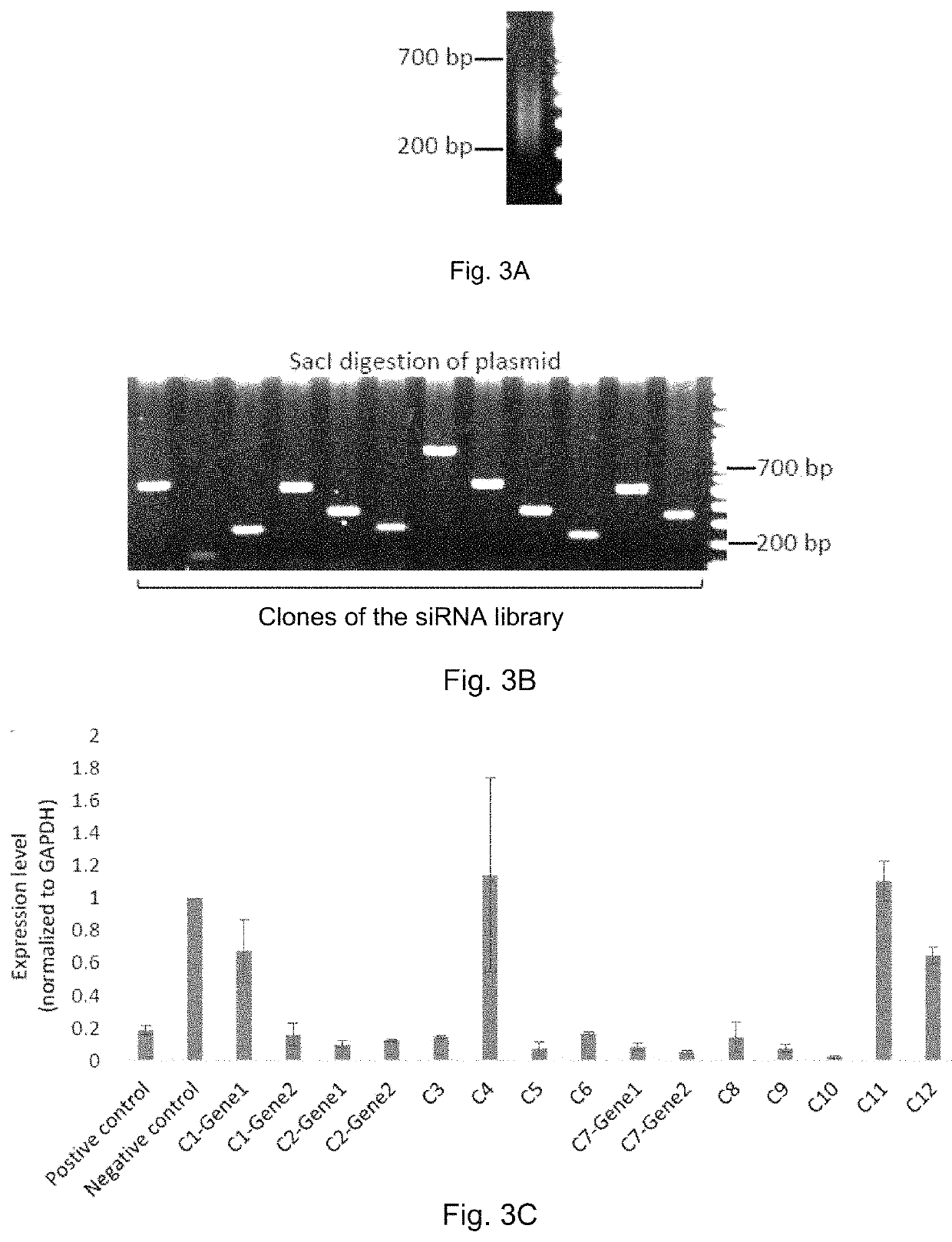Small-interfering RNA expression systems for production of small-interfering RNAs and their use
a technology of expression systems and rnas, which is applied in the field of small interference rna expression systems for production of small interference rnas and their use, can solve the problems of limited yield of sirna produced with usually applied methods from expression systems, affecting the stability of sirna or off-targeting, and limiting the use of commonly used sirna libraries accordingly
- Summary
- Abstract
- Description
- Claims
- Application Information
AI Technical Summary
Benefits of technology
Problems solved by technology
Method used
Image
Examples
example 1a
[0223]Preparing a Transcriptome-Wide Library of siRNA Expression Systems from HeLa Cancer Cells According to the Present Invention
[0224]The overall strategy of the siRNA library preparation and RNAi screen method is outlined in FIG. 1. Total RNA is from a certain target cell line and then converted into a dsDNA library inside a siRNA producing plasmid.
[0225]Total RNAs from HeLa-d1EGFP (HeLa cells with a EGFP transgene) were firstly extracted followed by ribosome RNA removal. RNA was fragmented into smaller pieces of ˜200 nucleotides to ˜700 nucleotides, and then converted into dsDNA fragments. The dsDNA fragments were then ligated via TA cloning method to a specially designed adaptor containing SacI restriction site (FIG. 2A) which matches the restriction site on the plasmid. The dsDNA fragments were then amplified by PCR (using a primer matching the adaptor), digested by SacI and finally ligated to the vector. FIG. 3A shows the DNA fragments after SacI adaptor ligation and PCR. In ...
example 1b
[0228]Silencing Efficiency of the siRNAs Produced from the siRNA Expression Systems
[0229]To test the silencing efficiency of the siRNAs produced using the siRNA library production method, siRNAs have been extracted from the twelve individual clones. Purified siRNAs (according to Huang and Lieberman, Nat Protoc, 2013, 8(12):2325-36) were transfected into HeLa-d1EGFP cells and qRT-PCR was performed to test the RNA silencing efficiency. The results (FIG. 3C) showed more than 80% knockdown of the target gene in 11 out of the 15 tests. These results demonstrate that a high percentage of siRNA library clones (>70%) can produce highly efficient siRNAs targeting their corresponding target genes, i.e. cleaving the corresponding RNA. Furthermore, for C2 and C7 the siRNAs can suppress both target genes proving that one siRNA library plasmid, if it contains multiple dsDNA fragments, i.e. multiple gene fragments, could produce siRNAs that can simultaneously suppress multiple genes.
[0230]In summa...
example 1c
[0231]Production of siRNA from a Library of siRNA Expression Systems According to the Present Invention
[0232]In order to cover the entire transcriptome of the target cell, the number of siRNA needed to be produced is in the thousands range. A high-throughput bacteria culture and siRNA isolation method has been created for the purpose of producing siRNA libraries containing thousands of individual siRNA expression systems (FIG. 4).
[0233]The siRNA library plasmid was firstly transformed into E. coli cells capable of supporting siRNA production. After overnight incubation at 37° C. on culture medium with antibiotic selection, individual clones were then inoculated into a well of 96 deep well plate pre-added with 1 ml culture medium. Each well the contained one unique dsDNA fragment of a specific sequence cloned in a vector. Thus each 96 well plate could produce 96 individual siRNAs. Multiple plates were prepared in the same manner to reach the number of thousands siRNAs. The plate was ...
PUM
| Property | Measurement | Unit |
|---|---|---|
| temperature | aaaaa | aaaaa |
| temperature | aaaaa | aaaaa |
| temperature | aaaaa | aaaaa |
Abstract
Description
Claims
Application Information
 Login to View More
Login to View More - R&D
- Intellectual Property
- Life Sciences
- Materials
- Tech Scout
- Unparalleled Data Quality
- Higher Quality Content
- 60% Fewer Hallucinations
Browse by: Latest US Patents, China's latest patents, Technical Efficacy Thesaurus, Application Domain, Technology Topic, Popular Technical Reports.
© 2025 PatSnap. All rights reserved.Legal|Privacy policy|Modern Slavery Act Transparency Statement|Sitemap|About US| Contact US: help@patsnap.com



